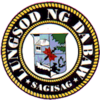Davao City
| Davao City Dakbayan sa Dabaw Lungsod ng Dabaw |
|||
|---|---|---|---|
| — City — | |||
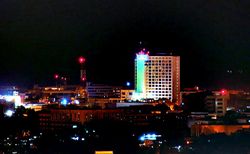 |
|||
|
|||
| Motto: "Love, Peace and Progress.","Island to Highlands" | |||
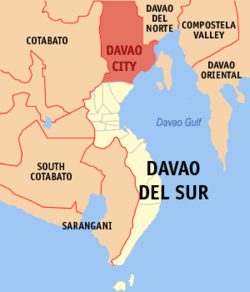 |
|||
 Davao City
|
|||
| Coordinates: | |||
| Country | Philippines | ||
| Region | Davao Region (Region XI) | ||
| Province | None | ||
| Districts | 1st to 3rd Districts of Davao City | ||
| Barangays | 184 | ||
| Incorporated (town) | 1848 | ||
| Incorporated (city) | March 16, 1936 | ||
| Government | |||
| - Mayor | Inday Sara Duterte-Carpio (LP/Hugpong sa Tawong Lungsod) | ||
| - Vice Mayor | Rodrigo Duterte (LP/Hugpong sa Tawong Lungsod) | ||
| Area | |||
| - Total | 2,444 km2 (943.6 sq mi) | ||
| Elevation | 22.3 m (73 ft) | ||
| Population (2007) | |||
| - Total | 1,363,337 as of August 1, 2,007 (CENSUS) | ||
| - Density | 558/km2 (1,445.2/sq mi) | ||
| Time zone | PST (UTC+8) | ||
| Area code(s) | 082 | ||
| Website | www.davaocity.gov.ph | ||
The City of Davao (Tagalog: Lungsod ng Dabaw; Cebuano: Dakbayan sa Dabaw) is the largest and de facto capital city located on the island of Mindanao in the Philippines. It is also one of the Philippines' most progressive cities. Its international airport and seaports are among the busiest cargo hubs in the southern part of the Philippines.
Davao City is also one of several cities in the Philippines that are independent of any province. The city serves as the regional center for Davao Region (Region XI). It has a population of 1,363,330 (2007 census) and is named by the Foreign Direct Investment Magazine as the 10th "Asian City of the Future".[1] In recent years, Davao City has emerged as the business, investment and tourism hub for the entire southern Philippines. The city boasts of some of the finest beaches and mountain resorts in the country and its proximity to the Philippines' most captivating diving spots as well as its highest peak, Mount Apo.
Contents |
History
Local historians of Davao claim that the word davao came from the phonetic blending of the word of three Bagobo subgroups when referring to Davao River, an essential waterway which empties itself into Davao Gulf near the city. The aboriginal Obos who inhabit the hinterlands of the region called the river, Davoh; the Clatta or Guiangans called it Duhwow, or Davau, and the Tagabawa Bagobos, Dabu. To the Obos, the word davoh also means a place "beyond the high grounds", alluding to the settlements located at the mouth of Davao River which were surrounded by high rolling hills. When asked where they were going, the usual reply is davoh, while pointing towards the direction of the town. Duhwow also refers to a trading settlement where they barter their forest goods in exchange for salt or other commodities.
Spanish influence was hardly felt in the Davao until 1848, when an expedition led by Don Jose Uyanguren came to establish a Christian settlement in an area of mangrove swamps that is now Bolton Riverside. Davao was then ruled by a chieftain, Datu Bago, who held his settlement at the banks of Davao River (once called Tagloc River by the Bagobos). After Uyanguren defeated Datu Bago, he renamed the region Nueva Guipúzcoa, in honor of his home in Spain, and became its first governor. Uyanguren's efforts to develop the area, however, did not prosper.
A few years after the American forces landed in 1900, private farm ownership grew and transportation and communication facilities were improved, thus paving the way for the region's economic growth.
A Japanese entrepreneur named Kichisaburo Ohta was granted permission to exploit vast territories which he transformed into abacá and coconut plantations. The first wave of Japanese plantation workers came onto its shores in 1903, creating a Little Japan. They had their own school, newspapers, an embassy, and even a Shinto Shrine. On the whole, they established extensive abaca plantations around the shores of Davao Gulf and developed large-scale commercial interests such as copra, timber, fishing and import-export trading. Filipinos learned the techniques of improved cultivation from the Japanese so that ultimately, agriculture became the lifeblood of the province's economic prosperity.
Because of the increasing influence of the Japanese in the trade and economy of region, on March 16, 1936, Romualdo Quimpo, the congressman from Davao filed Bill no. 609 and was subsequently passed as Commonwealth Act no. 51 creating the City of Davao from the Town of Davao (Mayo) and the Guianga District. The bill further called for appointments of the local officials from the President.[2]
Davao was formally inaugurated as a chartered city on October 16, 1936, by President Manuel L. Quezon.The City of Davao then became the provincial capital of the then undivided Davao Province.
On December 8, 1941 Japanese planes bombed the city. Japanese occupation started in 1942.
In 1945, American and the Philippine Commonwealth forces liberated Davao City from Japanese forces.
Thirty years later, in 1967, the Province of Davao was subdivided into three independent provinces, namely Davao del Norte, Davao del Sur, and Davao Oriental. The City of Davao was grouped with Davao del Sur and was no longer the capital. However, it became a center of trade for Southern Mindanao. Over the years, Davao has become an ethnic melting pot as it continues to draw migrants from all over the country, lured by the prospects of striking it rich in the country's third largest city.
In 1970's to present, Davao became the Regional Capital of Southern Mindanao and with the recent reorganization, became the regional capital of the Davao Region (Region XI).
Culture and heritage
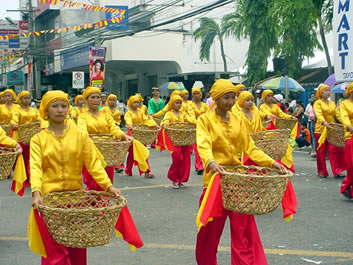
Easy assimilation is an integral essence of multi-cultural Davao. Being a chartered city, it has grown appreciating differences in culture and tradition by numerous ethnic groups that integrated easily to the local tribes already present during its infancy as a city.
Like most cities in the Philippines, Catholics largely populate Davao. Christian churches and chapels dot the city's landscape along with some temples, mosques, and other places of worship.
Another Spanish influence that remains up to this day is the observance and celebration of barrios (or villages) of the day of their respective patron saint called "Fiesta". It is in these celebrations wherein songs, dances and other forms of arts and merrymaking from various cultures have evolved creatively into the sights and sounds of Davao now. Such showcases point to its ultimate climax as the celebration of all celebrations - the weeklong Kadayawan sa Dabaw Festival.
Geography
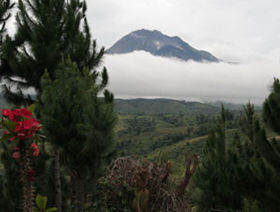
.
The land area of Davao City is 2,443.61 square kilometers. It is divided into 3 congressional districts, which are further divided into 11 administrative districts containing a total of 184 barangays. Almost 50% of its total land area is classified as timberland or forest. Agriculture utilizes about 43%. This is reflective of the fact that agriculture is still the largest economic sector. Big plantations that produce banana, pineapple, coffee, and coconut eat up a large chunk of the total land area.
Location
Davao City is approximately 588 statute miles southeast of Manila.
Traveling by sea, its location from Manila and Cebu is 971 and 593 nautical miles (1,098 km) respectively.
Presently, built-up areas used for residential, institutional, commercial, and industrial purposes represent about 10% of the total land area. Under the approved land use plan built-up and settlement area will cover 15% of the total area while agricultural will be maximized with 67.19%. The remaining 17.68 will be devoted to forestry and conservation.
Climate
Davao City is typhoon-free due to its location. Tropical storms and tidal waves are blocked by a peninsula. The city enjoys a weather that remains balmy all year round. It is characterized by a uniform distribution of rainfall, temperature, humidity, and air pressure. It has no pronounced wet or dry season. Weather predictability makes it highly conducive to agricultural production. Temperature ranges from 20 to 32 degrees Celsius and average rainfall is up to 2,000 mm yearly.
Language
Cebuano language is the most widely spoken language in the city, while Tagalog comes a distant second. though, a local "dabawenyo" dialect is also spoken by a few.
Bisaloglish, an informal mixing of the above languages, is spoken as well. English is the medium of instruction in schools and is widely understood and spoken especially in the business community and for all official documents. Other notable languages are Hiligaynon and Ilocano
A local Spanish based creole, Chavacano, a treasure of the cultural heritage from the Spanish era, is also spoken by immigrants from Cotabato and Zamboanga.
Religion
The most dominant group is the Roman Catholic at 80%, other Christian groups comprise 18% such as Protestant churches (Evangelicals, Born Again, Ang Dating Daan), and the remaining 1.17% belongs to other non-Christian faiths (Islam)
Accessibility
Davao City is very accessible and is the gateway to the Brunei-Indonesia-Malaysia-Philippines East Asia Growth Area or BIMP-EAGA.
By land
You will find roaming around the city streets accessible by the number of buses, jeepneys, multicabs, cabs (taxi) that run the city streets. Getting your way around Davao City is never a problem with the mode of transportation available.
Davao City also offers a wide bus network connection to major cities and provinces, not only in Mindanao but even as far as Manila and Pasay City in Luzon. Davao City is connected to Manila by a series of roll on roll off or inter-island ferry connection. You can reach Davao City by bus to and from all of the cities in Mindanao like Cotabato, Kidapawan, Digos, General Santos, Koronadal, Isulan, Tacurong, Tagum, Cagayan de Oro, Surigao, Butuan, Cebu City and Pasay City in Manila.
By sea
The city is also served by passenger ferries throughout the Philippines at Sasa Wharf and Sta. Ana Wharf.
- Sulpicio Lines twice weekly from Manila.
- SuperFerry twice weekly to Manila.
- Danspenta Fastcraft Ferry 3 time a day vice versa to Lupon.
By air
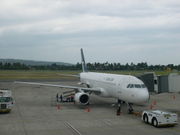
.
Davao City has direct flights to major cities in the Philippines and some Asian Cities. Francisco Bangoy International Airport (Davao International Airport) is currently being served by the following airline carriers:
- Cebu Pacific 4 flights weekly to Cagayan de Oro, 3 flights daily to Cebu City, Once daily flight to Iloilo City, 6 daily flights to Manila, and Once daily flight to Zamboanga City
- Philippine Airlines 5 daily flights to Manila and daily flights to Cebu City.
- SilkAir 4 flights weekly to Singapore
- Zest Airways One daily flight to Manila and Cebu
Economy

Davao City is the premier City and hub of Mindanao.It is a "Crown Jewel" of Mindanao in terms of economic activity. It is the most important economy in the island and the third most important urban center in the Philippines.
Like the rest of the country, Davao City operates on an economic system that is market-oriented, although pricing mechanisms remain regulated in a few sectors (particularly on basic commodities) to protect consumers. The competitiveness of the market has been enhanced through the dismantling of protection for "infant industries" and the breakdown of industries with monopolistic or cartel tendencies.
On the international front, the economy has been opened to global competition, through a tariff, private investments has Davao City's economy is steadily growing in the last two decades. The City has shifted counting investments from millions in the '80s to billions in the '90s and pool of skilled workforce. With close to 1.5-Million people as primary market base, the city is conducive to business as evidenced by the presence of the country's top 200 companies. Inflow of investments has been remarkable in the last ten years. Export in the City is now a billion dollar industry with a growing niche market for its products. The stable banana and flourishing pineapple industries are among the country's leading export commodities. A net exporter since 1987, Davao City largely contributed in making the Philippines as the world's top exporter of papaya, mangosteen, and even flowers.
The productive linkages between established businesses and Davao City community reinforced the competitive quality of life in a city that has consistently maintained single digit inflation rate since 1993. Along with flourishing investments and exports, the low inflation rate serve as concrete illustration of the remarkable gains from Davao City's sustained competitiveness nurtured by high level of responsiveness of the local government which put priority focus in facilitating business-friendly initiatives and in ensuring a peaceful and prosperous environment.
Government
Unique to the local government set-up of the city is the designation of a deputy mayor by the city mayor. Although an appointed official only, the deputy mayor serves as a direct link to the city mayor, especially for people living outside the city proper. The deputy mayor also serves as the city mayor's representative in community events. The functions of the position are considered complementary to the functions of the city vice-mayor, given the large territorial jurisdiction of the city.
The city is politically subdivided into 184 barangays.
The present mayor Sara Duterte-Carpio. The former Mayor, Rodrigo R. Duterte, now sits as vice mayor.
Davao City has 184 barangays with three legislative districts. As of the latest, Davao City will have a total of 948,428 registered voters expected to cast ballots for the May 10, 2010 National and Local Elections. It has actually 6,124 polling precincts, but since this will be the first time the country will conduct its first automated elections using the latest technology called Precinct Count Optical Scan, precincts are clustered to 1,172. The City Government of Davao is now proposing to add two more Congressional Districts to better serve the ever-growing population.
Newly Elected Officials starting June 30, 2010 DAVAO CITY
House of Representatives
1st District
- Rep. Karlo Alexei B. Nograles (Lakas-Kampi-CMD)
2nd District
- Rep. Mylene J. Garcia (Liberal/Hugpong)
3rd District
- Rep. Isidro Roy Ungab (Liberal/Hugpong)
City Officials
- Mayor - Sara Z. Duterte-Carpio (PDP-LABAN/Hugpong)
- Vice Mayor - Rodrigo R. Duterte (Liberal/Hugpong)
Councilors:
-
- 1st District
- AVISADO, Wendel E. (PDP-LABAN/Hugpong)
- LIBRADO, Leah A. (Bayan Muna/Hugpong)
- IBUYAN, Edgar R. (Liberal/Hugpong)
- GALICIA , Emmanuel D. (PDP-LABAN/Hugpong)
- QUITAIN, J Melchor V. (PDP-LABAN/Hugpong)
- BONGUYAN, Joan Mae (Lakas-Kampi-CMD)
- BRAGA, Pilar C. (NPC/Hugpong)
- ABELLERA, Nilo Jr. M. (Liberal/Hugpong)
-
- 2nd District
- BONGUYAN , Louie John J. (Liberal/Hugpong)
- APOSTOL , Dante L. (PDP-LABAN/Hugpong)
- CABLING , Arnolfo R B. (PDP-LABAN/Hugpong)
- MONTEVERDE , Tomas Iv J. (Liberal/Hugpong)
- ALEJANDRE , Alryan S. (NPC/Hugpong)
- DAYAP, April Marie C. (PDP-LABAN/Hugpong)
- DUREZA, Jimmy (Liberal/Hugpong)
- SALVADOR- ABELLA, Marissa P. (PDP-LABAN/Hugpong)
-
- 3rd District
- BELLO, Karlo S. (PDP-LABAN/Hugpong)
- ZOZOBRADO , Rachel P. (PDP-LABAN/Hugpong)
- DALODO-ORTIZ, Myrna G. (Liberal/Hugpong)
- AL-AG, Bernard E. (Liberal/Hugpong)
- VILLAFUERTE, Jose Louie (NPC/Hugpong)
- LOPEZ, Rene Elias C. (Lakas-Kampi-CMD)
- BALURAN, Conrado G. (NPC/Hugpong)
- ADVINCULA, Victorio Jr. (PDP-LABAN/Hugpong)
Legislative Districts of Davao City
| District | Sub-District (# of Barangays) |
Population (as of 2007) |
Barangays | ||||||||
|---|---|---|---|---|---|---|---|---|---|---|---|
| First | Poblacion (40) | 153,005 |
|
||||||||
| Talomo (16) | 360,010 |
|
|||||||||
| Second | Agdao (11) | 98,586 |
|
||||||||
| Buhangin (13) | 232, 865 |
|
|||||||||
| Bunawan (9) | 123,767 |
|
|||||||||
| Paquibato (13) | 38,266 |
|
|||||||||
| Third | Baguio (8) | 27,255 |
|
||||||||
| Calinan (19) | 76,024 |
|
|||||||||
| Marilog (12) | 42,718 |
|
|||||||||
| Toril (25) | 125,978 |
|
|||||||||
| Tugbok (18) | 83,863 |
|
|||||||||
aCreated into separate barangays under Sangguniang Panlungsod Ordinance No. 16103, ratified on July 25, 2004; taken from Barangay Pampanga.
Security and Civil Defense
The city government has invested millions of pesos to ensure the security of people living and working in Davao City. Aside from the usual forces of the Philippine National Police, a special military task force has been formed to insulate the city from terrorist attacks and other forms of criminality. The Task Force Davao, as it is named, is affiliated with the Philippine Army and is headed by an army colonel.
The city government also maintains a 24-hour emergency response system patterned after the 9-1-1 system used in the United States. People can dial the 911 number to report emergencies and criminal incidents (except for Globe land line subscribers).
A curfew on minors is also observed in the city. All business establishments, in particular bars and discos, are mandated by a city ordinance to refrain from selling alcoholic drinks beyond 2:00 am. Also, motorcycle drivers with no helmets and motorists with defective lights are not allowed to enter or drive in the city. Regular checkpoints in key parts of Davao City and at the city boundaries are conducted 24 hours to ensure the strict implementation of traffic rules.
The use of fireworks and other similar pyrotechnics, as well as smoking, is strictly prohibited in most of the city. Even outdoors, if you are under a roof of any kind, you are prohibited from smoking. Violators are made to pay hefty fines, perform community service, serve jail time, or a combination of the three. Littering is also prohibited.
Foreign relations
The influx of foreign visitors and the presence of expatriates and migrants in the city have prompted the governments of Japan, Palau, Malaysia, Indonesia and the United States to open consular offices in the city. An honorary consulate of the European country of Czech Republic was also established in the City. [3]
The US Embassy in the Philippines opened a virtual consulate where inquiries regarding visa issuances, foreign relations concerns and travel to the United States can be made on the Internet by e-mail and chat. The virtual consulate website [1] is maintained in coordination with Ateneo de Davao University, University of Mindanao, University of the Immaculate Conception, Holy Cross of Davao College and AMA Computer College.
Physical Infrastructure
The presence of basic infrastructure within the city such as airport, seaports, roads, bridges, telecommunications, condominiums, malls and first class hotels has sustained the economic growth in the last 10 years. Due to the city's unprecedented growth, a clamor for higher capacity infrastructures resulted to a number of modernization projects now ongoing to meet the demands of the new millennium.
Airport
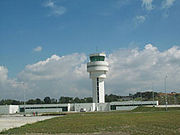
The Francisco Bangoy International Airport (Davao International Airport) is the busiest airport in Mindanao. Expansion and modernization began in 1998. Today, the new DIA (opened in December 2003) has begun accommodating larger jets such as the Boeing 747, the Airbus A330 and the Airbus A340.
Roads and bridges
Construction of more roads and bridges are also underway. The construction of the City's third major road - the Buhangin underpass was completed in the 1st quarter of 2003. A Traffic Management and Computerization Scheme was also implemented. The traffic lights in the city is considered as the most modern in Asia.[5] Davao City is ranked no. 5 among cities in Asia with better traffic flow based on vehicles per kilometer of city road. The DPWH is also preparing the Master plan for the Expressway Tagum City - Davao City - General Santos City.
Seaports
The Port of Davao has two government seaports Sasa International Wharf and Sta. Ana Domestic Wharf and 9 privately owned ports. In addition, the Toril International Fish Port Complex accommodates small and large-scale fishing activities as well as provide among others cold-storage facilities.
Telecommunications
Communication links within the key business areas are adequate. With the deregulation and privatization policies of the Philippine government, the number of telecommunications player is projected to increase as well as offer affordable telecommunications services to subscribers/clienteles.
Leading telecommunications companies put facilities in Davao City paving clear connections from and to various destinations in the Philippines and all over the world. The Philippine Long Distance Telephone Company (PLDT), Bayan Telecommunications Corporation (Bayantel), Globe Telecom, Smart Communications and Sun Cellular operate vital transmission towers in the city.
Internet service providers
There are six Internet Service Providers operating in Davao City offering dial-up, dedicated and DSL types of service. The City has over a hundred Internet cafés operating in strategic areas where one can surf, chat, play games, send and view e-mails, and engage in e-commerce using the latest computer innovation and technology.And soon new service provider Sulubit.
Existing and Proposed Malls
| Name | Address | Floor area (m²) |
|---|---|---|
| NCCC Mall Davao | MacArthur Highway, Davao City, | 86,800 m² (gross) |
| NCCC Main Magsaysay | Ramon Magsaysay Avenue, Davao City | |
| NCCC Centerpoint (November 2006) | (formerly Centro Supermart) Matina Crossing, Davao City | |
| NCCC Mall Lanang (Proposed) | Lanang, Davao City | |
| Chimes Shopping Center | Gov. Sales St., Davao City | |
| Victoria Plaza Mall | J.P. Laurel Ave., Davao City | |
| Gaisano Mall of Davao | J.P.laurel, Bajada, Davao City | |
| Gaisano South Citimall | Ilustre Street, Davao City | |
| SM City Davao | Quimpo Boulevard cor. Tulip Drive Ecoland Subd, Davao City | 75,440 m² (gross) |
| SM City North Davao/SM City Lanang (Proposed) | Damosa, Lanang Country Club, Davao City | 175000sq.m (gross) |
| Abreeza (Under Construction) | J.P Laurel Ave., Bajada, Davao City | 94.000 sq.m(gross) |
| Robinsons Cybergate Davao | Lanang, Davao City | 120sq.m(gross) |
Future developments
In recent years, Davao City maintained its competitiveness and now attracts big business and investments.Today, negotiations and constructions are going on to put up a project here in the city. The Ayala Land and Anflocor made a venture to build Abreeza, a P5 billion mall. It will have a 3-storey shopping mall and 2 Business Process Outsourcing (BPO) and a future hotel, residential and commercial lots.[6]
On the other hand, Four BPOs eye Davao for expansion. Four business process outsourcing (BPO) companies have trained their staff in their training facilities located in the city.
Tourism
Davao City is a romantic young city in the Philippines. It is one of the most beautiful cities in Asia. It is cosmopolitan and metro lifestyle.
Tourist Spots

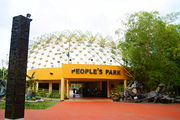
- Battle Memorial -– A historical marker of the longest-fought battle between the troops of the American & Filipino forces and of the Japanese Imperial Army which took place in Mintal, Tugbok District. (Mintal Elementary School)
- Camp Domingo Leonor -– Quarters of the Spanish and later American soldiers in the 1920s. (San Pedro St.)
- City Hall of Davao –- The former municipal building constructed in 1926. (San Pedro St.)
- Crocodile Farm –- The only crocodile park in the region provides home to locally bred crocodiles including the country's biggest crocodile named Pangil (or fangs) measuring over 18 feet (5.5 m) in length. On display are also dozens of species of birds and snakes, as well as tigers and great apes. One can take pleasure from viewing, horseback riding around the park, or feeding the young fierce reptiles.
- Davao Museum -– Houses artifacts of Davao's indigenous tribes and photographs of the city's historic events and history of its pioneering families. (Insular Village I, Lanang)
- Davao Historical Society Museum -– Features the historical and indigenous collections of the Davao Historical Society (Magsaysay Park)
- Fort of Datu Bago -- Site of the bastion of the Muslim hero Datu Bago who lorded over the Tagloc River, the old name of Davao River. (Junction of Washington St. and Quimpo Blvd.)
- Furukawa Plantation -– The abaca plantation in Daliao which was acquired from the Bagobos as a result of the Otha Public Land Act in 1903. (Toril)
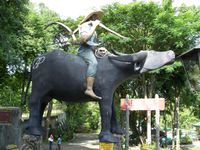
- Gap Farm -– The GAP Farm has deluxe cottages and campsites, Olympic size swimming pool, picnic area, horseback riding facilities, convention hall, and a World War II cave among others. Its garden is filled with exotic flowers and tropical fruits. Located in Barangay Ma-a.
- J.K. Mercado Corporation -- Founded in 1971 as a Philippine-based company with interests in the Agri-business, Hog Farming, Flori-culture and Tourism.
- Japanese Museum –- The museum features historical accounts of the Japanese community residing in Davao before and during the war including their tools which they used in the abaca plantations, currencies, publications, among others. (Calinan)
- Japanese Peace Memorial Shrine -– During the "Ubon Yasumi, " Japan's version of All Souls' Day held in August, Japanese war veterans and their kin take a pilgrimage to visit this memorial shrine. (Mintal)
- Japanese Tunnel -- A tunnel that the Japanese created in the time of the Japanese Revolution. 200 meters remains of the original 1 km of tunnels. Admission is 50 pesos for adults. (Matina)
- Lon Wa Buddhist Temple -- The biggest Buddhist temple in Mindanao is set in environment of candle trees and bamboo with an imposing statue of the Buddha and his life depicted in wood carving. (R. Cabaguio Ave.)
- Memorial to a Brave Son -- This memorial marker was built in recognition of the gallantry of Armando Generoso, who died in the very site of the bridge while defending it from the Japanese invaders during World War ll. (Gov. Generoso Bridge)
- Mindanao Taoist Temple –- Houses the holy icons of the Taoist religion. (J.P. Cabaguio Ave.)
- Mintal Historical Marker -– A memorial to Col. Yamada who defended Mintal during the war. It is also the site of the visit of McArthur, Stillwel and Eichelberger. (Mintal)
- Monument of Peace & Unity -– Unveiled during the celebration of the Philippine Centennial in 1998, the monument depicts the peaceful relationship of the migrant and indigenous inhabitants of Davao in the last 100 years. (San Pedro St.)
- Mosques -– Islam is also one of the major religions in the city with several places of worships found in Bankerohan, Quezon Blvd., Panacan, Quimpo Blvd., among others.
- Museo Dabawenyo -– a government owned museum located at cor. pichon st and claveria st.
- Old Japanese Houses -– The site of old Japanese homes, warehouses and abaca processing and drying plants before and during World War II. (Mintal, Tugbok District & Toril District)
- Osmeña Park -– Formerly known as the Plaza, this was the site of the settlement of the early Davaoeños. (San Pedro St.)
- Ottha Kyosaburu Memorial Shrine -– A memorial obelisk built in honor of Otha Kyosaburu who invoked the Public Land Act No. 926 of 1903. (Mintal Elementary School)
- Uyanguren Landing Site -– The landing site of Don Jose Oyanguren y Cruz of Guipuzcoa, Spain, the Spanish conqueror who later became the Governor of Davao. (Rodriguez Park, Quezon Blvd.)
.jpg)
- San Pedro Cathedral –- One of the oldest churches in Mindanao, the original structure of the church was built in 1847 in honor of St. Peter, the city's patron saint. The old altar is preserved at the right wing of the cathedral. (San Pedro St.). It is the ecclesiastical seat of the Archdiocese of Davao.
- Shrine of the Holy Infant Jesus of Prague -– A local mecca of the city's Roman Catholic devotees. (Shrine Hills, Matina)
- St. Mary of Perpetual Rosary -– A shrine built in honor of the Blessed Virgin Mary which features series of steps which leads to the main chapel. (Cabantian, Buhangin District)
- Talomo Beach –- Sunken warships during the Second World War used to be found just 200 meters from the shore until they were scrapped recently. (Talomo District)
- Eden Nature Park -- A very popular mountain resort located in Eden, Toril District, some 40 min away from the city center. It is situated 3,000 ft (910 m) above sea level, giving it a cool and moderate climate. It is 95% man made with pine trees dotting the landscape. It covers 40 hectares worth of developed land.
- Philippine Eagle Center -- Home to the Philippines National Bird, The Philippine Eagle (previously named Monkey Eating Eagle), the largest eagle in the World. It is where they are bred in captivity in order to increase their population and prevent extinction. Located in Malagos, a 45 min drive from the city center. Aside from being a temporary home for the Monkey Eating Eagle's, it also hosts some other exotic animals native to Davao's forest. As of April, 2010, 18 eagles are on display. Note that if you first visit the Crocodile Farm, you must wait 4 days before entering the Eagle Center to avoid disease transmission.
- Paradise Island and Beach Resort -- A very popular white sand beach resort located in Samal Island. It is a 5 min boat ride away from its drop off point at Lanang. Aside from its unspoiled waters, it also has a zoo as an added attraction.
- People's Park -- On December 15, 2007, Mayor Rodrigo Duterte led local officials in opening the P 72-M People's Park (old PTA Ground) in Davao City, which features a mini-forest and large sculptures representing indigenous groups in Southern Mindanao.[7]
Socio-cultural Environment
Health and Hospital

The average life expectancy of Davaoeños is 70 for females and 65 for males. There are about 31 hospitals with a total of 1,963 beds in Davao City. Very affordable medical services are made available to poor residents through the Southern Philippines Medical Center, which has the most hospitals beds at 1,200.
On the other hand, hospitals such as the Davao Doctors Hospital, San Pedro Hospital, Brokenshire Memorial Hospital, Ricardo Limso Medical Center, and Davao Medical Center now known as the Southern Philippines Medical Center are training hospitals that also offer specialized medical care services. Davao Regional Hospital in neighboring Tagum City, also offers the same quality specialized physician training and health services.
Psychiatric hospitals, psychotherapy clinics and counselling centers are also found in the city, directed and manned by internationally-trained counselors, psychologists, psychometricians and psychiatrists.
In Davao City, there are currently six large tertiary hospitals: Davao Doctors Hospital, San Pedro Hospital, Brokenshire Memorial Hospital, Davao Medical School Foundation Hospital, Ricardo Limso Medical Center, and Davao Medical Center.
Education
Davao City is the education hub in Mindanao.The University of the Immaculate Conception (formerly Immaculate Conception College) is the first Catholic school in the island of Mindanao founded in 1905 by the Congregation of the Religious of the Virgin Mary Sisters (RVM)

The government provides free education at the primary (grade school) and secondary (high school) levels. Government scholars from all over the region enjoy free college education in state-run universities such as the University of the Philippines, Mindanao[2] and the University of Southeastern Philippines. The literacy rate of the country is 93.9%. Davao City has a literacy rate of 98.05%.
Among the most popular tertiary schools located in Davao City are University of the Philippines - Mindanao, Ateneo de Davao University, University of the Immaculate Conception, Holy Cross of Davao College, San Pedro College, University of Mindanao, Davao Doctors College,Brokenshire College, Philippine Women's College of Davao, and University of Southeastern Philippines. Other schools in the city are Davao Central College, Inc., St. Peter's College of Toril run by the congregation of the Presentation of Mary Sisters, Assumption College of Davao run the Missionaries of the Assumption, Mindanao Kokusai Daigaku (or Mindanao International College), Stella Maris Academy of Davao (SMAD) run by the Hijas de Jesus, Holy Child School of Davao (HCSD), Philippine Academy of Sakya, Davao Christian High School, Davao Central High School, Rizal Special Education Learning Center, Davao Merchant Marine Academy (DMMA), MATS College of Technology, John Paul II College, AMA Computer College-Davao Campus , STI College of Davao, Rizal Memorial College, "Jose Maria College" run by the church founded by Pastor Apollo Quiboloy', and Rogationist Academy - Davao run by the congregation of the Rogationists of the Heart of Jesus.
The Davao Medical School Foundation also is the oldest medical school in Mindanao and is ranked 5th Best Medical School in the Philippines. As of the last Philippine Physician Licensure Exam held in 2008 and released in February 2009, the DMSF College of Medicine garnered an overall 81% passing, 88% among its first time takers as against the national passing average of 64%.
Many religious organizations established their schools of theology for the formation of their pastors, ministers and priests. The Roman Catholic Archdiocese of Davao has their Saint Francis Xavier Regional Major Seminary and the Saint Francis Xavier College Seminary. The United Church of the Philippines has its UCCP Pag-asa School of Theology. The Baptist churches established their own, the Southern Philippines Baptist Theological Seminary, Inc. and the General Baptist Bible College. Other fundamental churches have Christian Colleges of Southeast Asia Foundation located in Tulip Drive cor. Quimpo Blvd., Juna Subdivision, Davao City and the Mindanao Christian Foundation College and Seminary, Inc.
The city has contributed much to the Southern Mindanao's ever increasing pool of masters and doctorate degree holders helping the city gain the distinction of having one of the highest numbers of Masters in Business Administration (MBA) graduates in the region.
The city is considered the Center for Learning and Education in Southern Philippines. Currently, it has 374 elementary schools, 65 secondary schools including the Philippine Science High School- Southern Mindanao Campus which is one of the most premiere A-1 schools in the Asian Region, and 46 colleges and universities.
Media
Davao City, having over a million night-time population and an estimated 4 million day-time population is home to many media outlets. Large media networks maintain their respective local stations and branches for viewership, commercial and news coverage purposes. Most of these stations broadcast local news and public affairs as well as entertainment and dramas to cater the local viewers.
The television stations and their local frequency assignments are as following:
- TV5 Channel 2 run by the Associated Broadcasting Company
- ABS-CBN Channel 4 owned by ABS-CBN Broadcasting Corporation
- GMA Channel 5 owned by GMA Network Inc.
- ACQ-KBN Channel 43 owned by Sonshine Media Network International
- RPN Channel 9 Solar TV owned by Radio Philippines Network Inc.
- NBN Channel 11 run by the government through National Broadcasting Network
- IBC Channel 13 run by the government sequestered- Intercontinental Broadcasting Corporation
- SBN-7 ETC run by the Southern Broadcasting Network
- Q Channel 27 run by the GMA Network Inc. and Zoe Broadcasting Network Inc.
- Studio 23 run by ABS-CBN Broadcasting Corporation
Moreover, there are cable television operations in the city offering for a fee worldwide array of television stations for news, sports, science and technology, movies and documentaries, history and natural sciences, action and sci-fi, lifestyle and fashion, cartoons and children's shows, entertainment and showbiz-oriented programs and more.
Aside from the 24 national daily newspapers available, Davao City also has 20 local newspapers. Among the widely-read are the Sun Star Davao, Mindanao Times.
There are 15 AM-band radio stations in Davao City.
Davao City is enjoying a very large variety of FM-band radio stations. There are 19 FM stations in the city listened by over a million population extended to over 6 million listeners in Southern Mindanao, Northern Mindanao, Caraga Region, South-Central Mindanao or Socksragen and to as far as the Autonomous Region in Muslim Mindanao. These numbers reflect the extent of press freedom being enjoyed by the print and broadcast media as well as the provision of wide range of choice for residents and visitors alike.
AM radio stations
- DXAB 1296 kHz owned by ABS-CBN Broadcasting Corporation Shrine Hills, Matina, Davao City
- DXMF 576 kHz owned by Bombo Radyo Philippines San Pedro St., Davao City
- DXED 1224 kHz owned by Eagle Broadcasting Corporation located at JP Cabaguio Ave., Davao City
- DXFE 1197 kHz owned by the Far East Broadcasting Company with studios located at Marfori Heights, Davao City
- DXRD 711 kHz owned by ACQ-Kingdom Broadcasting Network located at F. Torres Street, Davao City
- DXRP 675 kHz owned by Philippine Broadcasting Service having their studios at Door 5, Tourism Complex Magsaysay Park, Davao City
- DXDC 621 kHz)owned by Radio Mindanao Network Inc. located at 2F San Vicente Bldg., Bonifacio St., Davao City
- DXOW 981 kHz) owned by Radyo Pilipino Corporation V. Mapa Street, Davao City
- DXRA 783 kHz owned by the RMC Broadcasting Corp. located at A. Pichon Street, Davao City
- DXIP 900 kHz) owned by the Southern Broadcasting Network Inc. located at Shrine Hills, Matina, Davao City
- DXUM 819 kHz owned by University of Mindanao Broadcasting Network located at Multi-test Bldg., Ponciano Reyes St., Davao City
- DXRR 1017 kHz owned by Kalayaan Broadcasting System situated in Bugac, Maa, Davao City
- DXGO 855 kHz owned by Manila Broadcasting Company with studios in Agdao, Davao City
- DXKT 1071 kHz)owned by Radio Philippines Network Inc. located at Marfori Heights, Davao City
- DXGM-AM 1125 kHz owned by RGMA Network Inc. located at Shrine Hills, Matina, Davao City
- DXQZ 1368 kHz Mabuhay Radio owned by the Mabuhay Broadcasting Systems Inc.
FM radio stations
-
- DWRX 99.5 Monster Radio BT 99.5 is a music FM radio station owned by Audiovisual Communicators Inc. The station's studio is located at the 4th Level Gaisano Carpark J.P Laurel Ave. Bajada, Davao City.
- DXDR 88.3 Energy FM owned by Ultrasonic Broadcasting System Inc. (UBSI). The station's studio is located along Shrine Hills,Matina, Davao City.
- DXBE or Killer Bee 89.1 is an FM radio station owned by Quest Broadcasting Inc.
- DXGN Good News Radio 89.9 mHz. owned by the Roman Catholic Archdiocese of Davao and is broadcasting in San Pablo Parish Compound, juna Subdivision, Davao City
- DXBM 90.7 Love Radio is an FM station of Manila Broadcasting Company in the Philippines. The station's studio is located at Matina, Davao City.
- DXWT Wild 92.3 WT is the flagship FM station of University of Mindanao Broadcasting Network. The station's studio is located at the UMBN Broadcast Center, P. Reyes Street, Davao City.
- DXLR 93.1 Crossover is a music FM station owned and operated by Mareco Broadcasting Network Inc.. The station's studio & transmitter are located at Valrose Building, CM Recto Street, Davao City
- DXXL 93.9 mHz. under the brand iFM, is a music FM station owned and operated by Radio Mindanao Network Inc. The station's studio is located at the 2/F San Vicente Bldg., Anda corner A. Bonifacio Sts.,Davao City
- DXLL Mellow 947 94.7mHz. is one of the provincial station of FBS Radio Network Inc. It is located in Midland Village, Ma-a, Davao City.
- DXDJ 95.5mHz. 95.5 Classic Hit Radio is an FM station of Rajah Broadcasting Network Inc. in Davao City. The station's studio is located at Ponciano Street, Davao City.
- DXSS 96.3 mHz. is the FM station of Southern Broadcasting Network, It beams from the Bombo Radyo Broadcast Center, San Pedro Street, Davao City.
- DXFX Star FM Davao 97.1 mHz. is an FM station owned by the Consolidated Broadcasting Systems and Bombo Radyo Philippines in Davao City.
- DXUR 97.9 Davao is an FM station in Davao City playing pop and rock music targeting young and yuppies.
- DXQM broadcasting as 98.7 Home Radio is an FM station of Aliw Broadcasting Corporation. It is located in Matina, Davao City, Philippines.
- DXRR, operating as MOR 101.1 Lupig Sila For Life!, is a FM station owned and operated by ABS-CBN Broadcasting Corporation in Davao City. The station's studios and transmitter are located at the Shrine Hills, Matina, Davao City.
- DXFM 101.9mHz. WAV 1019, is a music FM station owned and operated by Nation Broadcasting Corporation. It is located in Davao City.
- DXRV 103.5 Wow FM (DXRV-FM 103.5 MHz Davao City) is an FM station of RGMA Network Inc. (RGMA, a subsidiary of GMA Network Inc. It studios and transmitter is located at GMA Complex, Shrine Hills, Matina, Davao City.
- DXMA The Edge Radio 104.3 MHz owned and operated by United Christian Broadcasters Inc.
- DXYS or 105.1 Easy Rock formerly called Yes FM is owned by Cebu Broadcasting Company. It broadcasts from Matina, Davao City.
- DXMX 105.9 Mix FM owned by Omarco Broadcasting Network and is having their studios in t Doors 4 and 5, RJ Homes Bldg., Pelayo St., Davao City
- DXET or 106.7 Dream FM Davao is owned and operated by the Associated Broadcasting Company. Its studios and transmitters are located in ABC Heights,Shrine Hills, Matina, Davao City
- DXNU NU 107 Davao is an FM radio station of the Progressive Broadcasting Corporation
Sister cities
There are 8 sister cities in Davao as designated in Sister Cities International, Inc. (SCI):
|
|
Friendship Cities
 Uijeongbu, South Korea[8]
Uijeongbu, South Korea[8]
See also
- Silicon Gulf
- Mindanao
- Metro Davao
References
- ↑ "Asian Cities of the Future 2007/08"
- ↑ Davao, Reconstructing history from text to memory, Macario Tiu, author, Ateneo de Davao publisher 2005
- ↑ "About the Embassy | Embassy of the Czech Republic in Manila". Mzv.cz. http://www.mzv.cz/manila/en/about_the_embassy/index.html. Retrieved 2010-09-07.
- ↑ "Upgraded Davao City International Airport Is Ready for More Passengers and Bigger Aircraft"
- ↑ "Davao's new traffic system is "Asia's most modern"
- ↑ "Abreeza — Davao's own Greenbelt"
- ↑ Abs-Cbn Interactive, P72-M People's Park opens in Davao City oh yeah
- ↑ 8.0 8.1 "Davao, Korean city to ink sister-city pact"
External links
 |
Panabo City |  |
||
| Cotabato | Island Garden City of Samal | |||
| Santa Cruz, Davao del Sur |
|
|||||||||||
|
|||||||||||
| Leading population centers | |||||||
|---|---|---|---|---|---|---|---|
| Rank | City | Population | Pop. Growth Rate | Region | 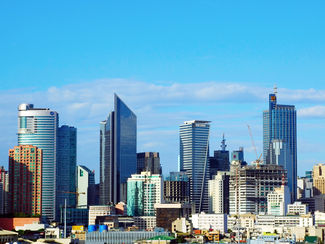 Metro Manila 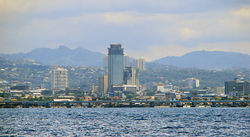 Cebu City |
||
| 1 | Quezon City | 2,679,450 | 2.53% | National Capital Region | |||
| 2 | Manila | 1,660,714 | 0.03% | National Capital Region | |||
| 3 | Caloocan | 1,378,856 | 2.53% | National Capital Region | |||
| 4 | Davao City | 1,363,337 | 1.81% | Davao Region | |||
| 5 | Cebu City | 798,809 | 2.16% | Central Visayas | |||
| 6 | Zamboanga City | 774,407 | 3.54% | Zamboanga Peninsula | |||
| 7 | Antipolo | 633,971 | 5.22% | CALABARZON | |||
| 8 | Pasig | 617,301 | 2.29% | National Capital Region | |||
| 9 | Taguig | 613,343 | 4.07% | National Capital Region | |||
| 10 | Valenzuela | 568,928 | 2.23% | National Capital Region | |||
| based on the Philippines 2007 Census | |||||||
